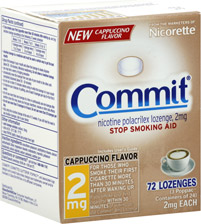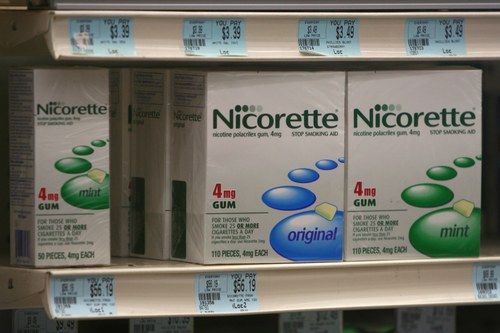
Nicorette, Commit lozenge and NicoDerm CQ cancer scares
Two new nicotine replacement therapy safety studies raise cancer concerns
Researchers have long known that NNN (N-Nitrosonornicotine) is a potent cancer causing chemical in animals. They know that nicotine is converted into nornicotine as tobacco ages, and that the curing and storage process somehow transforms nornicotine into the deadly carcinogen NNN. They know that additional NNN is created when tobacco is burned and inhaled by smokers. But imagine their horror upon discovering levels of NNN in the urine of nicotine gum and lozenge users that were 7, 31, 36 and 728 times higher than when smoking.
An October 2009 study published in the online version of Cancer Research found that urine NNN levels in 13 of 34 participants in two nicotine gum or lozenge studies were at times equal or greater than background urine NNN levels recorded while still smoking.
The below chart shows measurement of NNN in the urine of eight oral nicotine users in one portion of the study (POB data - see bottom of Table S1). Except for day 3, a week or more passed between urine samples. NNN's half-life inside the body is roughly three hours (184 minutes). NNN's three hour half-life means that within 24 hours more than than 99% of NNN can be eliminated from the body. Sampling urine just once in seven days, clearly, the below chart leaves gaping holes in our understanding of how high NNN spikes can actually rise and how frequently they occur.
Total NNN urine levels in eight (8) oral NRT users as measured in pmol/24h at both baseline while still smoking and on specific days after quitting smoking while using oral nicotine (nicotine gum or lozenge)
| User | Baseline | Day 3 | Day 7 | Day 14 | Day 21 | Day 28 | Day 42 | Day 56 |
| User #1 | 67 | 219 | - | 256 | 622 | 578 | 253 | 130 |
| User #2 | 81.5 | 88 | 59,400 | 1,250 | 11 | 558 | 6.8 | 118 |
| User #3 | 15 | 3.9 | 0.3 | 0.2 | 0.3 | 473 | 0.3 | 0.2 |
| User #4 | 6.5 | 3.2 | 2.7 | 0.2 | 0.3 | 0.3 | 2.9 | 0.3 |
| User #5 | 329 | 14 | 359 | 32 | 16 | 14 | 18 | 3.7 |
| User #6 | 665 | 17,900 | 103 | 18,200 | 3,310 | 23,900 | 4,080 | 8.7 |
| User #7 | 8.7 | 64 | 1.4 | 0.5 | 0.07 | 0.06 | .015 | .016 |
| User #8 | 4.4 | 0.1 | 0.1 | 0.1 | 0.06 | 0.1 | 0.1 | 0.17 |
We've known for a decade that applying NNN twice weekly for 28 weeks inside the nasal cavity of three month-old minks required an average of 97 weeks before resulting cancerous tumors invaded the mink's brain (1999 Koppang). What we don't know after 25 years of nicotine gum being on the market is whether or not long-term use of nicotine replacement therapy (NRT) causes cancer.
NNN's primary path of harm in mice, rats and hamsters is development of cancer in the esophagus, trachea and nasal passages (1992 Kopping). But what about humans? Do massive NNN urine spikes suggest concerns about kidney or bladder cancer?
 "In my opinion, the most likely cancers to be associated with long
term NRT use would be lung and upper aero-digestive tract. But we do not have sufficient epidemiologic data on either" says Stephen S. Hecht, Ph.D, a University of Minnesota cancer prevention professor and researcher, and a co-author of the Cancer Research study.
"In my opinion, the most likely cancers to be associated with long
term NRT use would be lung and upper aero-digestive tract. But we do not have sufficient epidemiologic data on either" says Stephen S. Hecht, Ph.D, a University of Minnesota cancer prevention professor and researcher, and a co-author of the Cancer Research study.
The U.S. Food and Drug Administration (FDA) first approved prescription nicotine gum in 1984. Today, roughly 40% of Nicorette users are hooked on the cure. President Obama is believed to be among them. Why has it taken a quarter of a century for researchers to realize that NNN spikes in the urine of oral nicotine users can be up to 700 times higher than when smoking?
"Only relatively recently have we developed a method for measurement of NNN in human urine," says Professor Hecht.
Professor Hecht assisted Professor Irina Stepanov, also of the University of Minnesota, in developing a process for measuring tobacco nitrosamines, including NNN. They co-authored an April 2005 paper in Cancer Epidemiology, Biomarkers & Prevention. It found that the mean level of NNN in the urine of 14 smokers was 0.18 pmol/mg, while the level in 11 smokeless tobacco users was 3.5 times higher at 0.64.
But doesn't an NNN urine finding of 59,400 pmol over 24 hours mean that long-term use of oral forms of NRT is unsafe?
"I do not think there are sufficient studies to assess the effects of long term NRT use - safe or unsafe," says Professor Hecht. "NRT is safer than smoking because it does not involve exposure to multiple other toxicants and carcinogens. But our study raises some concerns about NRT use which should be addressed by the manufacturers of these products."
How does the human body transform nicotine into nornicotine and then NNN? Does the e-cigarette's nicotine vapor mist cause massive NNN urine spikes too, or like the transdermal nicotine patch (which the October study also evaluated), will spikes be far less frequent and vastly less profound? And why does the method of nicotine delivery affect NNN levels? We're left with vastly more questions than answers.
Nitrosation is a process of converting organic compounds into nitroso derivatives. According to Professor Hecht, "There are many factors which can influence nitrosation by generating relatively high levels of nitrite in the acidic environment of the stomach, together with nornicotine. These could include diet, infections, and others."
Still, today, we do not know which oral NRT users will experience massive NNN spikes, what causes them, how high the spikes will go, how frequently they'll occur, whether they will cause cancer, and if so, where in the body cancer will result.

October 20, 2009 PLoS One Nicotine Study - Not only is nicotine transformed via nornicotine into the potent carcinogen NNN, nicotine itself promotes cancer. It does so by preventing diseased cells from dying (a natural process known as apoptosis) and by actually forming new blood vessels that nourish and feed tumors (angiogenesis). Now, for the first time, a study suggests the gravity of nicotine use while having a tumor.
A free online study in PLoS One found that mice wearing NicoDerm CQ patches experienced a 64% increase in the size of implanted tumors, over tumors in mice not wearing the patch. Nicotine's tumor growth effects were even greater in mice receiving injections of nicotine, where tumors were 3.2 times larger. What we don't yet know is whether nicotine's impact on tumor grow rates in humans will be similar to rates seen in mice.
"Once the tumors were surgically removed, nicotine treated mice had a markedly higher tumor recurrence (59.7%)" as compared to mice not receiving nicotine (19.5%). Nicotine also increased metastasis by 9 fold (900%), as measured by the rate by which cancer cells traveled from the flank or hind-end of mice (the tumor implant site) to their lungs.
"While nicotine has been demonstrated to induce cell proliferation, angiogenesis and growth of tumors, the studies presented here show for the first time that nicotine patches can promote tumor re-growth and metastasis," writes the study's authors. "Our results also show that a commercially available nicotine transdermal patch can promote the growth of tumors implanted into mice."
NRT Risk-Benefit Analysis - What neither paper mentions is NRT's lack of value as a smoking cessation aid, its real-world failure to prevail over those attempting to quit without it. Clearly, NRT is generally twice as effective as placebo controls inside randomized clinical trials. What's equally clear is that NRT trials were not blind as claimed, that 3-4 times as many placebo group members correctly guess their group assignment as guess wrong. It may be impossible to hide the onset of full-blown nicotine withdrawal from smokers with lengthy quitting histories, smokers skilled at recognizing it.
Clinical trials did not involve cold turkey quitters. Defeated placebo users joined seeking free NRT products. Unlike real cold turkey quitters, they did not expect to endure full-blown withdrawal. They expected free nicotine and a significantly less intense experience. Honest real-world competition with real cold turkey quitters provides mounting evidence that NRT clinical trial findings reflect frustrations, not effectiveness.
The most recent competition is from a 2018 PLos One study where cold turkey quitters trounced pharmacology quitters. Other findings include: results from a 2013 Gallup Poll; a July 2009 quitting survey by Nicorette maker GlaxoSmithKline; a 2006 unpublished U.S. National Cancer Institute survey of 8,200 quitters, as reported in the Wall Street Journal, Page A1, February 8, 2007; a study of "Smoking status of Australian general practice patients and their attempts to quit"; English smoking treatment services: one-year outcomes published in Addiction (See Table 6); a 2005 study by Alberg AJ entitled Nicotine replacement therapy use among a cohort of smokers; Tobacco In London, Facts and Issues (see Figure 14); a 2002 study by Boyle RG entitled Does insurance coverage for drug therapy affect smoking cessation?; and a 2002 Journal of the American Medical Association paper by Pierce JP entitled Impact of Over-the-Counter Sales on Effectiveness of Pharmaceutical Aids for Smoking Cessation.
Simon Chapman, Ph.D, is a public health professor at the University of Sidney and recently retired editor of the journal Tobacco Control. On September 18, 2009 he wrote, "For years, cold turkey has been denigrated as a hopeless strategy and ignored in public campaigns. But ask 1000 ex-smokers how they stopped and you get a very different answer." "[P]opulation studies consistently have shown that a large majority of smokers who permanently succeed in quitting do not use any form of assistance."
On July 17, 2009, Boston University School of Public Health Professor Michael Siegel, MD outlined ten concerns about NRT research and policy: (1) financial conflicts of interest; (2) biased presentations; (3) biased study conclusions; (4) inadequate conflicts disclosure; (5) ignoring pregnancy NRT safety and ineffectiveness findings; (6) ignoring population based studies showing cold turkey more effective than NRT; (7) recent studies showing unplanned quitting attempts twice as successful as planned attempts; (8) unusual pharmacology industry worry over the e-cigarette sales; (9) serious NRT blinding failure concerns; and (10) pharmaceutical industry reluctance to pit NRT against real cold turkey quitters.
Professor Siegel closes by asserting, "In light of these 10 problems, I believe that it is time for a serious re-examination of both the effectiveness of nicotine replacement therapy and the role of NRT as part of a national strategy for the promotion of smoking cessation."
Far too many pharmaceutical industry salesman have been allowed to masquerade for far too long as university cessation pharmacology research scientists. If addicted and alive, feel good not bad. Although a quarter of a century late, when hundreds of thousands should still be alive, science's cavalry (as shown by the above safety and effectiveness studies) is beginning to arrive.
Related Discussion

